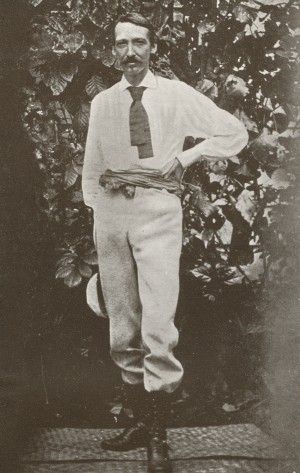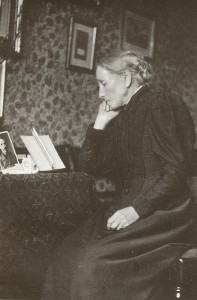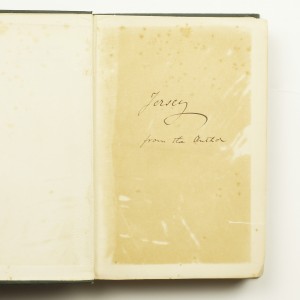Birthdays are usually a day when one can be a little self-indulgent. However, in an act of selflessness that can only be admired, Robert Louis Stevenson gave his birthday away to a friend’s 12 year old daughter. In 1891 he heard that Annie Ide (daughter of the US Commissioner to Samoa, Henry Clay Ide) was unhappy that her birthday fell on Christmas Day and that she received no special birthday celebrations, so he “deeded” her his special day, the 13th November. Intrigued by such an act, we decided to take a closer look at other women in the life of this anniversary philanthropist.

Born on 13th November 1850 into a prosperous Scottish family living in Edinburgh, R.L.Stevenson was a sickly child, inheriting his beautiful but frail mother’s tendency towards chest infections. His delicate health meant that he spent more time than was usual with his mother, and this, combined with his difficult relationship with his father, resulted in a particularly close bond between them. She introduced him to the joy of books at an early age, often reading to him in order to keep him amused during his frequent bouts of illness. In return he later presented copies of his own novels and poems to her, including the romantic tale of Prince Otto, which he wrote whilst living at his home in Skerryvore, Bournemouth.
However, his mother was not his only childhood companion. In 1852 when he was only 2, his parents employed a nurse to help care for him and Alison Cummingham, known as “Cummie”, looked after him devotedly, remaining in the Stevenson household until 1872 and even after leaving she and Stevenson maintained a lifelong correspondence.

(An image of Cummie from Robert Louis Stevenson Memories)
Her fondness for her charge was certainly reciprocated and his affection for this influential nurse is clear to see on the dedication page of his 1885 book of poetry, A Child’s Garden of Verses.
His poor health remained a constant problem to him, and as a young man he travelled to Europe to see if a better climate would help. Whilst there he met and fell in love with Fanny van der Grift Osbourne, an American with two small children. When she returned to San Francisco, Stevenson initially stayed in France as his parents would not finance his trip to America. Instead he went on a walking holiday, his recollections of which resulted in the publication of Travels with a Donkey in the Cevennes, which happily raised enough funds for him to follow Fanny, and they were finally able to marry in 1880.
They spent the next 7 years living in England and France, trying to avoid the sort of damp cold conditions that so exacerbated his condition. It was during this time that he wrote the most popular and enduring of his novels, including Treasure Island, published in 1883, which gave us the dastardly Long John Silver and through him an entire iconography of pirates, who Stevenson thought of as "lubbers and swabs, and downright dunces." Although women take a decidedly back seat in the novel, it is perhaps significant that the only female in the story is Jim’s mother, whose insistence on searching Billy Bone’s trunk and finding the treasure map sets her son off on his adventures. Since its publication numerous illustrators have been attracted to the book, from Edmund Dulac to Mervyn Peake and all have added their own interpretations of the piratical adventure.
Stevenson’s ill health impacted once again on his life and in 1888 he uprooted his family and travelled around the Pacific Ocean for the next 3 years, before finally settling on Samoa, where he built an estate in Vailima, and became immersed in the local life and politics.

(An image of RLS with his family and staff at Vailima, from Robert Louis Stevenson Memories)
In 1892 he met Margaret, Countess of Jersey who impressed him with her determination to discover the “real” Samoa. In August that year he disguised her as his cousin Amelia Balfour so she could visit, incognita, with the ladies of the rebel potentate’s royal household. Stevenson demonstrated the affection and esteem in which he held the Countess when he presented her with a copy of A Footnote to History, his impassioned denouncement of the treatment of the Samoans by the Empire’s bureaucrats.

His life long battle with ill health finally ended in December 1894, when sitting at home with Fanny, he suffered a fatal stroke and died.
His stories may often have been adventure tales about and for boys, but his own adventures were heavily influenced by women, and it therefore seems entirely fitting that he gave up his birthday to little Annie.
122 years after his act of kindness we would rather like to once again wish Robert Louis Stevenson a very happy birthday.
Read more about Robert Louis Stevenson's Life and Works.
Recent Posts
- The Evolution of Crime
- Tour The Bookshop On Your Screen
- The Genesis of Mr. Toad: A Short Publication History of The Wind In The Willows
- Frank Hurley's 'South'
- The "Other" Florence Harrison
- Picturing Enid Blyton
- Advent Calendar of Illustration 2020
- Depicting Jeeves and Wooster
- Evelyn Waugh Reviews Nancy Mitford
- The Envelope Booklets of T.N. Foulis
- "To Die Like English Gentlemen"
- Kay Nielsen's Fantasy World
- A Brief Look at Woodcut Illustration
- The Wealth Of Nations by Adam Smith
- What Big Stories You Have: Brothers Grimm
- Shackleton's Antarctic Career
- Inspiring Errol Le Cain's Fantasy Artwork
- Charlie & The Great Glass Elevator
- Firsts London - An Audio Tour Of Our Booth
- Jessie M. King's Poetic Art, Books & Jewellery
Blog Archive
- January 2024 (1)
- January 2023 (1)
- August 2022 (1)
- January 2022 (1)
- February 2021 (1)
- January 2021 (1)
- December 2020 (1)
- August 2020 (1)
- July 2020 (2)
- March 2020 (3)
- February 2020 (2)
- October 2019 (2)
- July 2019 (2)
- May 2019 (1)
- April 2019 (1)
- March 2019 (2)
- February 2019 (1)
- December 2018 (1)
- November 2018 (1)
- October 2018 (2)



